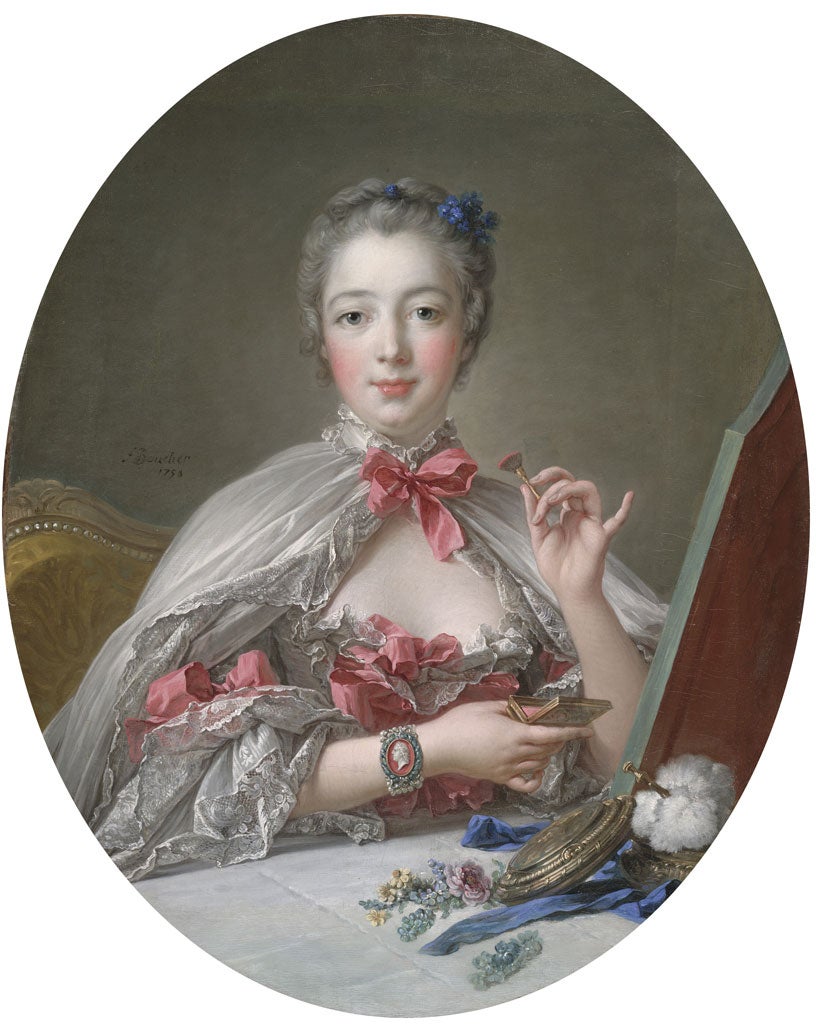Great Works: Madame de Pompadour at Her Toilette, 1750-c1760 (81.2cm x 64.9cm), by François Boucher
Fogg Art Museum, Harvard

Your support helps us to tell the story
From reproductive rights to climate change to Big Tech, The Independent is on the ground when the story is developing. Whether it's investigating the financials of Elon Musk's pro-Trump PAC or producing our latest documentary, 'The A Word', which shines a light on the American women fighting for reproductive rights, we know how important it is to parse out the facts from the messaging.
At such a critical moment in US history, we need reporters on the ground. Your donation allows us to keep sending journalists to speak to both sides of the story.
The Independent is trusted by Americans across the entire political spectrum. And unlike many other quality news outlets, we choose not to lock Americans out of our reporting and analysis with paywalls. We believe quality journalism should be available to everyone, paid for by those who can afford it.
Your support makes all the difference.The fleeting, easily erasable, puffed-away-on-the-wind splendours of the rococo spirit are perfectly embodied in the work of François Boucher. And here is just one of those many cream puffs of his.
It is all made up, you might say, this painting about the art of the application of make-up in the fastness of the mistress's boudoir. And the last part to be done – and we catch it at the moment when it has just been done – is the beautification of the face, having first beautified the rest of the body with a lovely, wafty peignoir and a carelessly crinkly (crushably crinkly, we feel, which adds to the overall sense of flimsy, easily-blown-away promise) bow at the throat, which leads down to a milky expanse of bosomy promise, lifted just a touch by her right hand, which also holds, open, the much deadlier promise of the rouge box. Red for danger. Red for seduction. And, of course, rouge-red as evidence of a healthy complexion. The hair is delicately, dustily, powdered. And, just in front of her, as if scattered rather freely, there is an artfully artless clutter of feminizing mysteries – the blue scarf that rhymes with the blue posy in her hair, a white powder puff, and much else.
The painting is an act of mirroring, you might say. Even though Madame de Pompadour has a mirror propped in front of her, she turns her face towards us with a mixture of calculated innocence and cool brazenness, as if we are the mirror into which she flirtatiously gazes, with the utmost self-satisfied composure. And as she does so, we the onlookers become that mirror – the painting encourages this conceit by being in the shape of an oval mirror – to her all-consuming fancies relating to the enduring potency of her beauty. We become her utterly passive, besotted slaves. We are here to show patience, and to encourage her own narcissistic self-absorption, as she perfects her appearance – which is the best of her, of course. The surface glitter of herself is what she has to offer. We are here to let her be reflected back at herself. Nothing is as it seems, of course. We know this from the facts. She was 37 years old – she would die five years later – when Boucher made this portrait, and her skin was in a terrible condition. All that harsh truth is smoothed away by the magical application of make-up. Well, not quite smoothed away. There is just a hint of a double chin, for example, and a pudginess about the clasping hand. We feel that we know that Boucher has lied about the eyes too, their lovely, deep, doe-like symmetry... According to at least one contemporary account, her eyes were not large, but these eyes seem just a touch pleadingly large for the face. There is a mask-like serenity here too. So little is amiss here that something must be amiss.
For all that, the portrait aims to catch her at this exquisite moment of self-satisfied aftermath. This is the best that she will be. Once out of the boudoir, there will be the general murk and leery mess of the world to begin to ruin it all. The hand holding the brush is moving away from the face, fingers delicately unfurling, slow-motion, flower-like. Voila! the painting seems to be saying. According to the 19th-century historian Thomas Carlyle, Madame de Pompadour had something of an addiction to rouge. It was the last thing to go on after the hair had been powdered and the rest of the maquillage applied. So profound was her addiction in fact, that, according to Carlyle again, she applied rouge for the very last time after the last rites had been pronounced over her dying body. She was determined to go perfectly prinked and prettified into that dark night.
About the artist: François Boucher (1703-70)
François Boucher was the near-perfect embodiment of the rococo spirit. He painted several likenesses of Madame de Pompadour and, thanks to her influence, he became court painter to Louis XV. Boucher made much superficial and light-hearted play with mythological themes, which fitted perfectly the superficial tastes of the king who employed him. To be in the company of gods in a bibulous, amorous or frivolous mood was a perfect antidote to the wearisome demands of high office.
Join our commenting forum
Join thought-provoking conversations, follow other Independent readers and see their replies
Comments